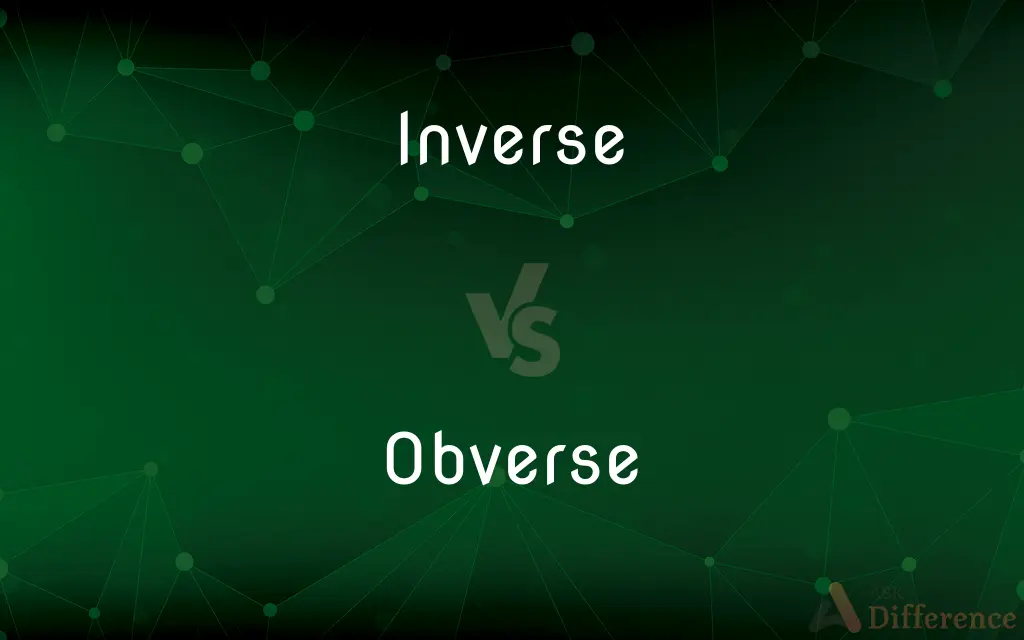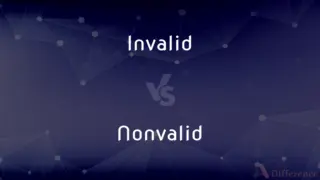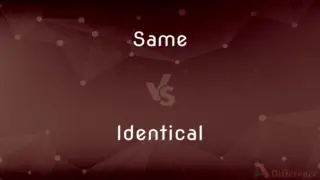Inverse vs. Obverse — What's the Difference?
By Maham Liaqat & Fiza Rafique — Updated on March 28, 2024
Inverse refers to something directly opposite in relation or effect, while obverse denotes the front or principal side of something, such as a coin.

Difference Between Inverse and Obverse
Table of Contents
ADVERTISEMENT
Key Differences
Inverse typically pertains to a relationship or condition where one element is directly opposite to another in order or magnitude. For example, in mathematics, the inverse of a function reverses the effect of the original function. Obverse, on the other hand, commonly refers to the front or more significant side of objects like coins or medals, showcasing the primary design or emblem.
In mathematics, the concept of inverse is used to describe operations or functions that undo each other, such as addition and subtraction or multiplication and division. The obverse concept, however, is more physical and tangible, often relating to the identification and categorization of objects based on their primary features or designs.
While inverse is a term that implies a conceptual or abstract relationship between elements, obverse is used to physically distinguish between the different sides of objects, indicating a more concrete differentiation. Inverse operations or functions can apply to numbers, equations, and logical statements, while obverse details are specific to physical objects and their symbolic or practical importance.
The use of inverse is crucial in various fields such as mathematics, physics, and logic, where understanding the relationship between opposing concepts or operations is fundamental. The obverse, however, is particularly relevant in numismatics (the study of coins and medals), art, and design, where the distinction between the front and back sides of objects holds historical, aesthetic, or monetary value.
Inverse and obverse serve different purposes and contexts; inverse is key in theoretical, analytical, and problem-solving scenarios, providing insight into the nature of relationships between quantities or operations. Obverse, by contrast, is significant in the classification, description, and appreciation of physical items, emphasizing their primary or most notable features.
ADVERTISEMENT
Comparison Chart
Definition
Opposite in position, direction, order, or effect.
The front or principal side of an object, especially a coin or medal.
Field of Use
Mathematics, physics, logic.
Numismatics, art, design.
Nature
Conceptual, relational.
Physical, tangible.
Example Context
Inverse functions in mathematics.
The obverse side of a coin displaying a head or emblem.
Importance
Key in understanding relationships and solving problems.
Essential for classification and appreciation of physical objects.
Compare with Definitions
Inverse
Something opposite in relation, direction, or effect.
The inverse of multiplication is division.
Obverse
The front side of a coin or medal, typically featuring a significant design.
The obverse of the coin features the portrait of the president.
Inverse
Used to describe inversely proportional relationships.
Pressure is inversely related to volume in Boyle’s law.
Obverse
The study of coins and their designs.
Numismatists analyze the obverse designs to determine a coin’s origin.
Inverse
Essential in problem-solving and theoretical analysis.
Finding the inverse of a matrix is crucial in solving linear equations.
Obverse
Represents the primary face or emblem.
The obverse of the medal bears the national emblem.
Inverse
The opposite of a given statement.
The inverse of “If it rains, then it pours” is “If it does not rain, then it does not pour.”
Obverse
Focuses on the aesthetic and symbolic elements.
The obverse design of the new series of coins was chosen through a national competition.
Inverse
(Mathematics) Of or relating to an inverse or an inverse function.
Obverse
The opposite side is known as the reverse.
While the obverse shows the leader’s face, the reverse displays the year of minting.
Inverse
Reversed in order, nature, or effect.
Obverse
Facing or turned toward the observer
The obverse side of a statue.
Inverse
(Archaic) Turned upside down; inverted.
Obverse
Serving as a counterpart or complement.
Inverse
Something that is opposite, as in sequence or character; the reverse.
Obverse
The side of a coin, medal, or badge that bears the principal stamp or design.
Inverse
The reciprocal of a designated quantity. Also called multiplicative inverse.
Obverse
The more conspicuous of two possible alternatives, cases, or sides
The obverse of this issue.
Inverse
The negative of a designated quantity. Also called additive inverse.
Obverse
(Logic) The counterpart of a proposition obtained by exchanging the affirmative for the negative quality of the whole proposition and then negating the predicate
The obverse of "Every act is predictable" is "No act is unpredictable.".
Inverse
Opposite in effect, nature or order.
Obverse
Turned or facing toward the observer.
The obverse side of the gravestone has the inscription.
Inverse
Reverse, opposite in order.
Obverse
Corresponding; complementary.
When you speak clearly, people understand you. If you don't mumble, the obverse effect is observed.
Inverse
(botany) Inverted; having a position or mode of attachment the reverse of that which is usual.
Obverse
(botany) Having the base, or end next to the attachment, narrower than the top.
An obverse leaf
Inverse
(mathematics) Having the properties of an inverse; said with reference to any two operations, which, when both are performed in succession upon any quantity, reproduce that quantity.
Multiplication is the inverse operation to division.
Obverse
The heads side of a coin, or the side of a medal or badge that has the principal design.
The medal had a cross on the obverse and had a name inscribed on the reverse.
Inverse
(geometry) That has the property of being an inverse (the result of a circle inversion of a given point or geometrical figure); that is constructed by circle inversion. Category:en:Curves
A circle inversion maps a given generalized circle to its inverse generalized circle.
Obverse
(logic) A proposition obtained by obversion, e.g. All men are mortal => No man is immortal.
Inverse
Whose every element has an inverse (morphism which is both a left inverse and a right inverse).
Obverse
Having the base, or end next the attachment, narrower than the top, as a leaf.
Inverse
An inverted state: a state in which something has been turned (properly) upside down or (loosely) inside out or backwards.
Cowgirl is the inverse of missionary.
321 is the inverse of 123.
Obverse
The face of a coin which has the principal image or inscription upon it; - the other side being the reverse.
Inverse
The result of an inversion, particularly:
Obverse
Anything necessarily involved in, or answering to, another; the more apparent or conspicuous of two possible sides, or of two corresponding things.
The fact that it [a belief] invariably exists being the obverse of the fact that there is no alternative belief.
Inverse
The reverse of any procedure or process.
Uninstalling is the inverse of installation.
Obverse
The more conspicuous of two alternatives or cases or sides;
The obverse of this issue
Inverse
(mathematics) A ratio etc. in which the antecedents and consequents are switched.
The inverse of a:b is b:a.
Obverse
The side of a coin or medal bearing the principal stamp or design
Inverse
(geometry) The result of a circle inversion; the set of all such points; the curve described by such a set.
The inverse P‘ of a point P is the point on a ray from the center O through P such that OP × OP‘ = r² or the set of all such points.
Inverse
(logic) The non-truth-preserving proposition constructed by negating both the premise and conclusion of an initially given proposition.
"Anything that isn't a dog doesn't go to heaven" is the inverse of "All dogs go to heaven." More generally, is the inverse of and is equivalent to the converse proposition .
Inverse
(mathematics) A second element which negates a first; in a binary operation, the element for which the binary operation—when applied to both it and an initially given element—yields the operation's identity element, specifically:
Inverse
(addition) The negative of a given number.
The additive inverse of is , as , as is the additive identity element.
Inverse
(multiplication) One divided by a given number.
The multiplicative inverse of is , as , as the multiplicative identity element.
Inverse
(functions) A second function which, when combined with the initially given function, yields as its output any term inputted into the first function.
The compositional inverse of a function is , as , as is the identity function. That is, .
Inverse
(category theory) A morphism which is both a left inverse and a right inverse.
Inverse
(card games) The winning of the coup in a game of rouge et noir by a card of a color different from that first dealt; the area of the table reserved for bets upon such an outcome.
Inverse
A grammatical number marking that indicates the opposite grammatical number (or numbers) of the default number specification of noun class.
Inverse
(surveying) To compute the bearing and distance between two points.
Inverse
Opposite in order, relation, or effect; reversed; inverted; reciprocal; - opposed to direct.
Inverse
Inverted; having a position or mode of attachment the reverse of that which is usual.
Inverse
Opposite in nature and effect; - said with reference to any two operations, which, when both are performed in succession upon any quantity, reproduce that quantity; as, multiplication is the inverse operation to division. The symbol of an inverse operation is the symbol of the direct operation with -1 as an index. Thus sin-1 x means the arc or angle whose sine is x.
Inverse
That which is inverse.
Thus the course of human study is the inverse of the course of things in nature.
Inverse
Something inverted in sequence or character or effect;
When the direct approach failed he tried the inverse
Inverse
Reversed (turned backward) in order or nature or effect
Inverse
Opposite in nature or effect or relation to another quantity ;
A term is in inverse proportion to another term if it increases (or decreases) as the other decreases (or increases)
Common Curiosities
How are inverse operations used in mathematics?
Inverse operations in mathematics, such as addition and subtraction, are used to solve equations and understand relationships between numbers.
What is the obverse of a coin?
The obverse of a coin is its front side, usually featuring a primary design such as a national emblem or a leader’s portrait.
What does inverse mean?
Inverse refers to something that is directly opposite in relation, order, or effect.
Why is the obverse of a coin important?
The obverse of a coin is important for identifying the coin, understanding its value, and appreciating its design and historical significance.
Can a concept have an inverse?
Yes, concepts, especially in mathematics and logic, can have inverses that represent opposite or negating relationships.
How do numismatists use the obverse of coins?
Numismatists use the obverse of coins to classify, date, and assess the historical and cultural significance of coins.
Is the obverse the same as the front?
Yes, in the context of coins, medals, and similar objects, the obverse is considered the front side.
What is the significance of inverse relationships in science?
Inverse relationships in science help in understanding natural laws and phenomena, such as the inverse square law in physics.
What is an example of an inverse function?
An example of an inverse function is the logarithm, which is the inverse of exponentiation.
Do all coins have an obverse and reverse side?
Yes, all coins have an obverse (front) and reverse (back) side, each typically featuring different designs.
How can understanding inverses help in real life?
Understanding inverses can help in problem-solving, such as calculating change or adjustments in recipes, and in scientific reasoning.
Can there be multiple inverses for a function?
For a function to have an inverse, it must be bijective (one-to-one and onto). Most functions have a unique inverse, if they have one at all.
What role does the design of the obverse play in coin collecting?
The design of the obverse plays a crucial role in coin collecting, affecting the coin’s desirability, collectability, and value.
What features are typically found on the obverse of coins?
Features on the obverse of coins often include national symbols, historical figures, or significant cultural emblems.
Can the concept of obverse be applied to things other than coins?
While primarily used in relation to coins and medals, the concept of obverse can apply to any object with a distinguishable front and back.
Share Your Discovery

Previous Comparison
Invalid vs. Nonvalid
Next Comparison
Same vs. IdenticalAuthor Spotlight
Written by
Maham LiaqatCo-written by
Fiza RafiqueFiza Rafique is a skilled content writer at AskDifference.com, where she meticulously refines and enhances written pieces. Drawing from her vast editorial expertise, Fiza ensures clarity, accuracy, and precision in every article. Passionate about language, she continually seeks to elevate the quality of content for readers worldwide.
















































